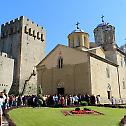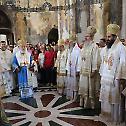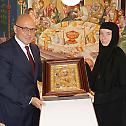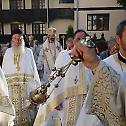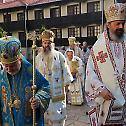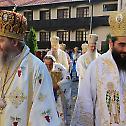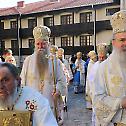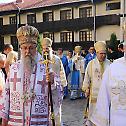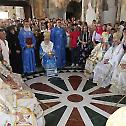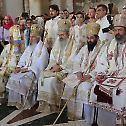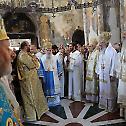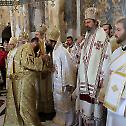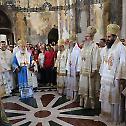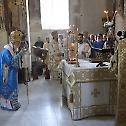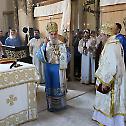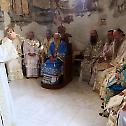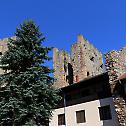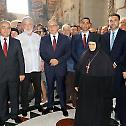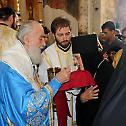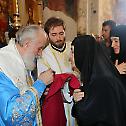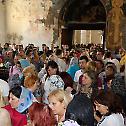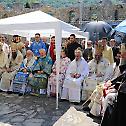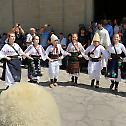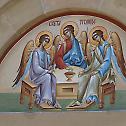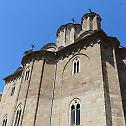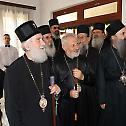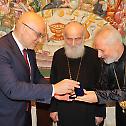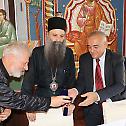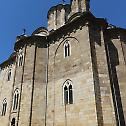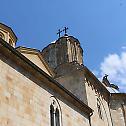Six Centuries of the Manasija Monastery
In the monastery of Manasija, foundation of Despot Stefan Lazarevic, six centuries of this sanctity of our faith was celebrated with the solemn Hierarchal Liturgy on Sunday, August 5th, 2018.
His Holiness Irinej, Serbian Patriarch, officiated the Holy Liturgy with the concelebration of the host Bishop of Branicevo, His Grace Ignjatije, and hierarchs of the Serbian Orthodox Church: His Eminence Metropolitan Porfirije of Zagreb-Ljubljana and Their Graces Bishops Lukijan of Budim, Pahomije of Vranje, Jovan of Sumadija, Joanikije of Budimlje-Niksic, Teodosije of Raska-Prizren, Andrej of Austria-Switzerland, Arsenije of Nis and Isihije of Mohacs, venerable monks, priests and deacons of the Holy Serbian Church. A mixed church choir of the Diocese of Branicevo sang responses.
His Holiness Patriarch held a festal address, congratulated High Venerable abbess Pavla and her sisterhood the six centenary of the monastic ministry and expressed desire that they, with God’s support, might continue to perform their spiritual role which the Manasija monastery has had for centuries.
During the festive diner, Minister of Culture in the Government of the Republic of Serbia Mr. Vladan Vukosavljevic held a speech and presented to abbess Pavla an icon of Most Holy Mother of God.
The Floral Triodion, a liturgical book translated into Serbian and published by the Diocese of Buda, was given by Director of the Office for Cooperation with Churches and Religious Communities Dr. Mileta Radojevic to the monastery, wherease Mrs Mirjana Andric, Director of the National Institute for Protection of Cultural Monuments, presented the “Monograph of the Resava monastery from the beginning of its restoration works”.
The gathering was attended by representatives of the Republic of Serbia and Republic of Srpska, Minister of Culture and Information Vladan Vukosavljevic, representatives of the city authorities, Director of the Office for Cooperation with Churches and Religious Communities Dr. Mileta Radojevic with his assistant Dr. Marko Nikolic, priesthood and monks of the Diocese of Branicevo, the faithful from several dioceses of the Serbian Church, personalities from public and cultural life; Nebojsa Bradic, editor-in-chief of the Cultural Program of the RTS with associates…
History of Manasija Monastery
Manasija Monastery was built by Despot Stefan Lazarevic, between 1406 and 1418.
In the Battle of Kosovo, in 1389, Serbian king Lazar was killed, leaving his underaged son Stefan to rule the state. After this, Serbia became Ottoman vassal, and Stefan occasionaly helped the Ottoman Empire with his army. He was later promoted into a "despot", which is a royal title, by the Byzantine Emperor. During his rule, he tried to balance between Hungarian and Ottoman empires, saving the independence of already weakened Serbian state as he best could.
Stefan Lazarevic has been remembered as a noble and brave leader, as well as an excellent artist (his famous poem Word of Love is considered to be the beginning of Serbian love poetry). Manasija Monastery is his most important foundation. He was supposed to be buried there, but due to sudden death in 1427, he was eventually buried in Koporin Monastery, also one of his foundations.
A couple of years after Manasija Monastery was built, a manuscript copying workshop, known as Resava School, was opened within the premises, putting the monastery on the map of Medieval Serbia as an important cultural and educational center.

